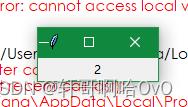Python tkinter:动态显示信息的两种方式「最详细解答」
Posted 轩哥啊哈OvO
tags:
篇首语:本文由小常识网(cha138.com)小编为大家整理,主要介绍了Python tkinter:动态显示信息的两种方式「最详细解答」相关的知识,希望对你有一定的参考价值。
各位好,我是轩哥啊哈~ 有小伙伴私信我如何让tkinter窗口上的元件内的数据实现动态显示,今天分享两种方法~
一、after()函数
如果你的窗口元件较少,使用tkinter内置的after()函数并使用一个递归,就可以实现动态显示。
示例:
def update():
global i
i += 1
label1['text'] = str(i)
label1.after(1000, update)
label1 = tk.Label(root, text='0', width=10)
label1.pack()
label1.after(1000, update)这样就可以实现label1中的数字每秒增加1。
after函数语法:after(几毫秒后, 调用的函数)
但是,如果你的窗口庞大,元件较多,使用过多的递归会导致CPU占用过大。这时候,多线程就成为了更好的方法。
二、多线程
使用threading库的多线程Thread(),可以实现动态显示:
i = 0
def update():
global i
while True:
i += 1
label1['text'] = str(i)
time.sleep(1)
label1 = tk.Label(root, text='0', width=10)
label1.pack()
update_thread = threading.Thread(target=update)
update_thread.start()这样也可以实现label1中的数字每秒增加1。
threading语法:threading.Thread(target=调用的函数)
三、完整代码
方法一:
import tkinter as tk
i = 0
def update():
global i
i += 1
label1['text'] = str(i)
label1.after(1000, update)
root = tk.Tk()
root.title("动态显示")
label1 = tk.Label(root, text='0', width=10)
label1.pack()
label1.after(1000, update)
root.mainloop()
方法二:
import time
import threading
import tkinter as tk
i = 0
def update():
global i
while True:
i += 1
label1['text'] = str(i)
time.sleep(1)
root = tk.Tk()
root.title("动态显示")
label1 = tk.Label(root, text='0', width=10)
label1.pack()
update_thread = threading.Thread(target=update)
update_thread.start()
root.mainloop()

希望对大家有帮助~
python 读取并显示图片的两种方法
在 python 中除了用 opencv,也可以用 matplotlib 和 PIL 这两个库操作图片。本人偏爱 matpoltlib,因为它的语法更像 matlab。
一、matplotlib
1. 显示图片
import matplotlib.pyplot as plt # plt 用于显示图片 import matplotlib.image as mpimg # mpimg 用于读取图片 import numpy as np lena = mpimg.imread(‘lena.png‘) # 读取和代码处于同一目录下的 lena.png # 此时 lena 就已经是一个 np.array 了,可以对它进行任意处理 lena.shape #(512, 512, 3) plt.imshow(lena) # 显示图片 plt.axis(‘off‘) # 不显示坐标轴 plt.show()
2. 显示某个通道
# 显示图片的第一个通道 lena_1 = lena[:,:,0] plt.imshow(‘lena_1‘) plt.show() # 此时会发现显示的是热量图,不是我们预想的灰度图,可以添加 cmap 参数,有如下几种添加方法: plt.imshow(‘lena_1‘, cmap=‘Greys_r‘)
plt.show()
img = plt.imshow(‘lena_1‘)
img.set_cmap(‘gray‘) # ‘hot‘ 是热量图 plt.show()
3. 将 RGB 转为灰度图
matplotlib 中没有合适的函数可以将 RGB 图转换为灰度图,可以根据公式自定义一个:
def rgb2gray(rgb): return np.dot(rgb[...,:3], [0.299, 0.587, 0.114]) gray = rgb2gray(lena) # 也可以用 plt.imshow(gray, cmap = plt.get_cmap(‘gray‘)) plt.imshow(gray, cmap=‘Greys_r‘)
plt.axis(‘off‘) plt.show()
4. 对图像进行放缩
这里要用到 scipy
from scipy import misc lena_new_sz = misc.imresize(lena, 0.5) # 第二个参数如果是整数,则为百分比,如果是tuple,则为输出图像的尺寸 plt.imshow(lena_new_sz) plt.axis(‘off‘) plt.show()
5. 保存图像
5.1 保存 matplotlib 画出的图像
该方法适用于保存任何 matplotlib 画出的图像,相当于一个 screencapture。
plt.imshow(lena_new_sz) plt.axis(‘off‘) plt.savefig(‘lena_new_sz.png‘)
5.2 将 array 保存为图像
from scipy import misc misc.imsave(‘lena_new_sz.png‘, lena_new_sz)
5.3 直接保存 array
读取之后还是可以按照前面显示数组的方法对图像进行显示,这种方法完全不会对图像质量造成损失
np.save(‘lena_new_sz‘, lena_new_sz) # 会在保存的名字后面自动加上.npy img = np.load(‘lena_new_sz.npy‘) # 读取前面保存的数组
二、PIL
1. 显示图片
from PIL import Image im = Image.open(‘lena.png‘) im.show()
2. 将 PIL Image 图片转换为 numpy 数组
im_array = np.array(im)
# 也可以用 np.asarray(im) 区别是 np.array() 是深拷贝,np.asarray() 是浅拷贝
3. 保存 PIL 图片
直接调用 Image 类的 save 方法
from PIL import Image I = Image.open(‘lena.png‘) I.save(‘new_lena.png‘)
4. 将 numpy 数组转换为 PIL 图片
这里采用 matplotlib.image 读入图片数组,注意这里读入的数组是 float32 型的,范围是 0-1,而 PIL.Image 数据是 uinit8 型的,范围是0-255,所以要进行转换:
import matplotlib.image as mpimg from PIL import Image lena = mpimg.imread(‘lena.png‘) # 这里读入的数据是 float32 型的,范围是0-1 im = Image.fromarray(np.uinit8(lena*255)) im.show()
以上是关于Python tkinter:动态显示信息的两种方式「最详细解答」的主要内容,如果未能解决你的问题,请参考以下文章